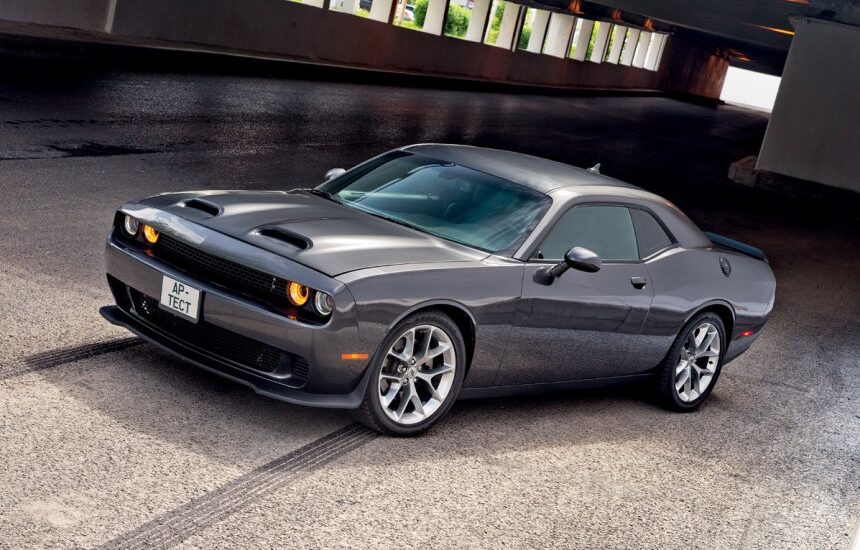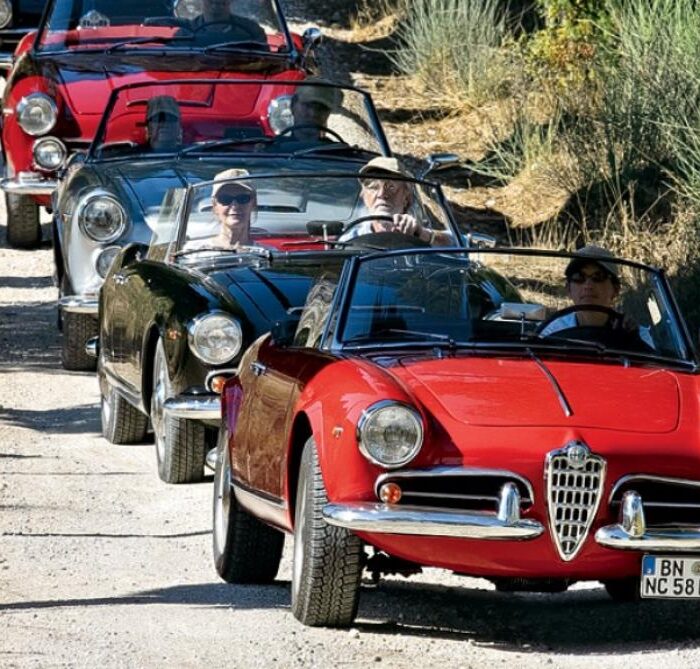Редакция Auto Review с легкой долей иронии решила поручить написание прощальной статьи о недавно снятом с производства Dodge Challenger писателю, который последние два года ездит на Tesla. Возможно, это сделало бы статью более интригующей? В конце концов, я провел почти неделю за рулем этого черного Dodge, размышляя о том, пришло ли время спеть реквием по V8, или его эра действительно прошла.
Попросите меня описать типичный мускул-кар, и я скажу, что он большой, тяжелый, архаичный и несколько неповоротливый. Но при этом он ревет так яростно, что птицы в близлежащих лесах падают с веток – действительно, клише. На этом фоне создание увлекательной статьи казалось сложной задачей. Поэтому я погрузился в архивы Auto Review в поисках фундаментального материала и… ничего не нашел. На страницах журнала я писал о Chevrolet Camaro (который некоторое время официально продавался в России) и Ford Mustang, но Dodge Challenger никогда не привлекал такого внимания. Таким образом, эта прощальная статья стала дебютной – как для журнала, так и лично для меня.
Впервые имя Challenger появилось в 1959 году: двухдверный седан Dodge Silver Challenger был всего лишь специальной версией модели Coronet.
Первое поколение Dodge Challenger (1969-1974) предлагалось с рядными «шестерками» (3,2-3,7 л) и двигателями V8 (5,2-7,2 л). Было выпущено 165 тысяч автомобилей.
Это упущение показательно. Оригинальный Challenger семидесятых годов на протяжении всего своего недолгого существования оставался в тени своих американских конкурентов из «большой тройки». Он дебютировал через пять лет после Mustang и через три года после Camaro. Это было так же бесполезно, как приходить на грибную охоту в полдень. В то время как Ford и Chevrolet грелись в лучах финансового успеха, Dodge с трудом удалось продать 165 000 экземпляров за пять лет, после чего модель была снята с производства – разительный контраст с ежегодными показателями продаж Mustang в то время.
Топливный кризис семидесятых отразил в Challenger второго поколения унылую эпоху, появившись в виде унылой версии компактного Mitsubishi Galant Lambda. Оснащенный скромными четырехцилиндровыми двигателями объемом от 1,6 до 2,6 л в сочетании с пятиступенчатой механической или трехступенчатой автоматической коробкой передач, он больше напоминал суповую кухню, чем мускул-кар. После пяти лет бесчестья Challenger исчез из модельного ряда Dodge на четверть века, чтобы затем возродиться в эпоху ренессанса.
Второе поколение Dodge Challenger (1978-1983) производилось в Японии. За все время производства было продано 107 тысяч автомобилей с четырехцилиндровыми двигателями 1,6 и 2,6.
Начало XXI века стало золотой эрой для мирового автомобилестроения, отмеченной подражаниями, ремейками и трибьютами. Все началось с европейских компактов, таких как Volkswagen Beetle и Mini, но американцы ответили на это восхитительно: Chevrolet с SSR и Camaro, Chrysler с PT Cruiser и Crossfire, а Ford с Mustang и GT. Это были не просто смелые шаги – это были заявления.
Концепт 2006 года превратился в серийный Dodge Challenger с минимальными изменениями. Производство на заводе в Канаде началось весной 2008 года.
Dodge Challenger стал частью этого возрождения. И снова он был представлен через четыре года после последнего Mustang. Однако его разработка велась далеко не с нуля. Третье поколение Challenger было построено на укороченной платформе LX, которая также использовалась для Chrysler 300, Dodge Magnum и Dodge Charger. Эта платформа была продуктом неудачного слияния DaimlerChrysler, целью которого было объединение немецкого и американского автомобилестроения. Так, передняя подвеска была позаимствована у Mercedes-Benz S-Class (W220), а задняя – у E-Class (W210), среди прочих заимствований.
Challenger впечатляет своими размерами: он всего на несколько сантиметров короче S-Class (W220) и почти на семь сантиметров шире. Поверьте, это существенно! Двухдверное купе размером с роскошный седан само по себе производит впечатление. А когда его размеры сочетаются с ретро-дизайном, стилизованным под культовый Challenger первого поколения, который к новому тысячелетию приобрел культовый статус, эффект многократно усиливается.
В то время как Mustang и Camaro с годами превратились в более утонченные автомобили, Challenger остался верен своим истокам, избежав значительных рестайлингов. Его дерзкая агрессивность, сопла капота и высокая линия пояса с резким подъемом к задней стойке были не просто элементами автомобиля, а настоящей концентрацией тестостерона. Владение и наслаждение этим Dodge требовало изрядной доли мужества.
Конечно, ощущения зависели от модели. У Challenger было почти столько же вариантов, сколько команд НБА. Модели начального уровня оснащались двигателями V6 с естественным всасыванием мощностью от 253 до 309 лошадиных сил, которые, что интересно, стали доступны с полным приводом только после 2017 года – в лучшем случае символический жест.
Прощальный Dodge Challenger SRT Demon 170 стал самым мощным в линейке: на смеси E85 наддувный V8 выдает до 1039 л.с. Было выпущено 3300 таких дорожных драгстеров.
Серьезный разговор начинается с версии R/T (Road and Track), оснащенной каноническим 5,7-литровым двигателем V8 Hemi мощностью от 377 лошадиных сил. Выше по карьерной лестнице располагались модели с 6,4-литровым V8 с естественным всасыванием, выдающим до 485 лошадиных сил. Версия SRT Hellcat 2015 года ознаменовала собой качественный скачок, получив 6,2-литровый V8 с наддувом, выдающий не менее 717 лошадиных сил. А самый дикий заводской Challenger мог похвастаться удивительными 1039 лошадиными силами!
Черный Dodge Challenger из сервиса по аренде автомобилей autobnb был моделью R/T 2021 года. Привезенный из Америки в качестве подержанного автомобиля, он был скромно тюнингован: впускной фильтр K&N с нулевым сопротивлением, резонаторы и насадки Magnaflow на выхлоп, а также тюнинг Stage 1. Все эти изменения подняли мощность V-образной «восьмерки» с 377 до примерно 405 лошадиных сил. Когда-то впечатляющие, сегодня такие показатели…
Электромобили быстро утратили привлекательность высоких мощностей и технических характеристик. И если вспомнить, что стандартный Dodge разгоняется до 100 км/ч за пять с половиной секунд, то старые стереотипы остаются в силе: он большой, тяжелый и не особо быстрый. Но если звезды зажигаются, значит, есть что-то, что стоит исследовать. И первый сюрприз оказался внутри салона.
Я ожидал увидеть примитивный, если не сказать откровенно скучный, интерьер, в котором нет ничего, кроме подстаканников. Но Dodge Challenger далек от этого. Он может похвастаться приятным дизайном, пресловутым пластиком soft-touch и многофункциональным рулевым колесом – все это придает ему ощущение современного автомобиля, по крайней мере, в комплектации T/A (Trans Am). В эту комплектацию входит мультимедийная система Uconnect с большим (ха-ха!) 8,4-дюймовым монитором, сиденья с памятью и вентиляцией, двухзонный климат-контроль, подогрев руля, аудиосистема Alpine и другие необходимые опции. В общем, все самое необходимое для джентльмена присутствует.
Но давайте будем честными: все, что связано с программным обеспечением, кажется застрявшим в 2008 году. Графика на экране рудиментарна, разрешение камеры составляет всего 0,1 мегапикселя, а сенсорный экран вялый. Даже мой старый BMW F30 3-Series 2012 года выпуска был на порядок выше в этих областях, не говоря уже о Tesla Model 3, на которой я сейчас езжу. Dodge пытается идти в ногу со временем, но это не всегда удается.
При этом эргономика заслуживает похвалы. Глубокие, низко посаженные сиденья Recaro с замшевой обивкой удобны, а рулевое колесо регулируется по высоте и вылету. Средний водитель ростом около 1,8 метра будет чувствовать себя как дома. Высокий центральный тоннель и кластер аналоговых кнопок под правой рукой создают ощущение кокпита. Хотя в Challenger это больше похоже на пребывание в укрепленном бункере: темный салон, узкие окна-щели, компактные боковые зеркала – ко всему этому нужно привыкнуть.
Этот автомобиль вообще требует акклиматизации, особенно когда речь идет о громком двигателе. Нажимаешь на кнопку запуска, и четырехсотсильный V8 тут же оживает, говоря вам: «Приготовьтесь, сейчас мы повеселимся!». Но этот агрессивный рык может быстро надоесть, особенно когда вы ползете по московским пробкам, пытаясь добраться из пункта А в пункт Б. Здесь Dodge ощущается как тигр в клетке, готовый наброситься, но деваться некуда.
Инженеры искренне старались сделать это купе более подходящим для повседневной езды. В комфортном режиме рулевое управление легкое и несколько расплывчатое, реакция на нажатие педали газа приглушенная, а торможение адекватное. Но Challenger все равно кажется слишком большим автомобилем – слишком большим, слишком громким, слишком мощным и слишком всамделишным. После нескольких дней езды на нем по Москве я обнаружил, что сижу на балконе и думаю: «Кто покупает такие машины, особенно в городе? Зачем нужны четыреста лошадей и пять метров наката? Или… это просто признак того, что я старею?»
Когда мне было 25 лет, мне однажды выпал шанс сесть за руль Audi R8 на целый день, и я не потерял ни минуты. Я ездил на нем везде и во всех режимах. Ощущения были настолько яркими, что они до сих пор хранятся в моей памяти. Так может, дело не в машине, а во мне? Единственный способ выяснить это – сойти с балкона и вернуться на парковку.
Dodge Challenger, однако, никогда не нуждается в убеждении. Он всегда готов зарычать, лишь бы в баке было топливо. Все, что вам нужно, – это прямая дорога, чтобы позволить двигателю подняться выше четырех тысяч оборотов, и тогда вы начнете понимать, почему люди влюбляются в эти автомобили.
Если вы ожидаете, что я буду восторгаться глубоким, басовитым рыком культового американского V8, вы можете быть разочарованы. Этот Hemi не звучит так, как мой Cadillac Fleetwood Brougham с аналогичным объемом двигателя. Возможно, это из-за модификации выхлопной системы, но Challenger не просто рычит – он кричит! Причем так громко, что пешеходы ныряют за деревья, а из окон соседних квартир сыплются проклятия. Звериный рев опьяняет, и вы обнаруживаете, что хотите слышать его снова и снова – каждый раз, когда загорается зеленый свет, каждый раз, когда вы выезжаете на открытую дорогу, каждый раз, когда вы вспоминаете, что в комплектации T/A предусмотрен контроль запуска для наиболее драматичного старта. В эти моменты вы забываете о статистике производительности и показателях ускорения. Все дело в эмоциях.
Да, Tesla Model 3 (и большинство современных электромобилей) быстрее, но стерильное ускорение, которое они предлагают, не идет ни в какое сравнение с висцеральным восторгом от нажатия на педаль газа Challenger. Не случайно кнопка отключения звука расположена рядом с кнопкой спортивного режима. В идеале здесь же должна быть кнопка одновременного опускания обоих боковых стекол, позволяя реву наполнить салон.
Однако важно не отвлекаться. Потому что независимо от того, в каком режиме вы находитесь, Challenger – по крайней мере, во время взлета – захочет покрутить шины и отдать задний ход. А если на середине разгона вы врежетесь в трамвайные рельсы, лучше поторопиться, чтобы поймать машину. Это захватывающее зрелище!
Однако если отвлечься от адреналиновых переживаний, можно обратить внимание на детали. Например, восьмиступенчатая автоматическая коробка передач ZF хорошо работает в большинстве ситуаций, но есть заметная задержка, когда вы нажимаете на газ. Конечно, у Challenger есть ручной режим и подрулевые переключатели, но как часто вы ими пользуетесь? После езды на Tesla, где задержек в работе трансмиссии просто не существует, даже PDK от Porsche начинает казаться медленным по сравнению с ним.
С другой стороны, подвеска удивляет в хорошем смысле. Где традиционная американская валкость? Где крены и расхлябанность кузова? Этого нигде нет. Но есть одна загвоздка: дорожные бригады могли бы использовать парк этих Dodge для проверки качества дорожного покрытия. Выбоины, швы, колеи – вы вдруг осознаете, как много недостатков на московских дорогах. По крайней мере, здесь не приходится качаться на пологих волнах и не мучает морская болезнь. Это лучше, чем ездить на желатине.
Управляемость? Ожидания и реальность снова столкнулись: Dodge управляется лучше, чем я думал. Даже в легком комфортном режиме вы хорошо чувствуете, что происходит с передними колесами и их углом поворота. Но в поворотах нет никакого стремления к пределу. Независимо от того, какие кнопки вы нажимаете или какой режим вождения выбираете, Challenger остается огромным купе весом почти две тонны. Физика не позволяет ему легко прогибаться, особенно без адаптивной подвески, которой у этого Dodge нет. Здесь используются пассивные амортизаторы и пружины. Тормоза с опциональными перфорированными дисками делают все возможное, но они не являются непобедимыми. Слишком быстро войдите в поворот, и вы проскочите его. Перестарайтесь с дросселем на выходе из поворота, и вы зацепите заднюю ось. Классика. После пары таких промахов вы, вероятно, дважды подумаете, прежде чем снова доводить этого американского зверя до предела.
Так что же Challenger делает лучше всего?
Он позволяет вам наслаждаться звуком двигателя! Поправить заднюю ось на взлете. Почувствовать необработанную мужественность, которую он воплощает. В этом Challenger превосходит всех. Но достаточно ли этого? Ведь даже на рынке подержанных автомобилей восьмицилиндровые Challenger начинаются от 4 миллионов рублей, а цены могут легко перевалить за 10 миллионов.
Передавая ключи владельцу Николаю, я не удержался и спросил его, почему после продажи своего шестицилиндрового Challenger SXT он решил купить еще один американский автомобиль – на этот раз более мощный R/T. Его ответ, как и ожидалось, не имел ничего общего с финансами. Николай ненадолго пересел на кроссовер Volvo XC60, но не смог вынести его вождения. Конечно, он был удобен и универсален. Но и скучен до смерти. Это был не автомобиль, а просто транспорт. И вот теперь в его московском дворе снова стоит пятиметровый американский мускул-кар с 5,7-литровым V8.
Эти автомобили больше не будут производиться. И это потеря! Dodge не только снял с производства Challenger (производство закончилось в декабре прошлого года), но и полностью отказался от двигателей V8. Семейство Hemi прекратит производство в этом году, а это значит, что больше никаких V8 в автомобилях Jeep, Ram или Chrysler. Новый Dodge Charger, доступный как трехдверный или пятидверный лифтбек, оснащается турбированной рядной шестеркой или электрическим двигателем. Это быстрее, эффективнее и экологичнее, но мускул-кары всегда были о чем-то другом – о том, чего не смогут предложить будущие Dodge.
Судьба Chevrolet Camaro еще более мрачна: он был снят с производства без какого-либо преемника. Эти решения кажутся еще более загадочными, если учесть, что Ford не намерен отказываться от двигателей V8. Генеральный директор Ford Джим Фарли недавно заявил, что они будут устанавливать «восьмерки» на Mustang’ы до тех пор, пока «Бог и политики позволят». Вот это подход, достойный уважения!
Но давайте пока не будем отчаиваться. Stellantis, материнская компания Dodge, имеет опыт отмены решений – даже тех, которые уже были реализованы. Так что, кто знает? Возможно, после небольшого перерыва двигатели V8 вернутся, когда они поймут, что продавать эмоции без них невозможно. Давайте подождем и посмотрим.
| Спецификация | Подробности |
| Модель автомобиля | Dodge Challenger R/T |
| Тип кузова | Двухдверное купе |
| Количество мест | 5 |
| Размеры (мм) – Длина | 5027 |
| Размеры (мм) – Ширина | 1923 |
| Размеры (мм) – Высота | 1465 |
| Колесная база (мм) | 2946 |
| Колея перед/зад (мм) | 1610/1620 |
| Коэффициент сопротивления (Cx) | 0.365 |
| Объем багажника (L) | 459 |
| Снаряженная масса (кг) | 1889 |
| Полная масса автомобиля (кг) | 2404 |
| Тип двигателя | Бензиновый, с непосредственным впрыском |
| Расположение двигателя | Передний, продольный |
| Количество и расположение цилиндров | 8, V-образный |
| Рабочий объем двигателя (куб. см) | 5654 |
| Диаметр цилиндра/ход поршня (мм) | 99.5/90.9 |
| Степень сжатия | 10.5:1 |
| Количество клапанов | 16 |
| Максимальная мощность (л.с./кВт/об/мин) | 377/277/5200 |
| Максимальный крутящий момент (Нм/об/мин) | 542/4400 |
| Трансмиссия | Автоматическая, 8-ступенчатая |
| Тип привода | Задний |
| Передняя подвеска | Независимая, пружинная, на двойных поперечных рычагах |
| Задняя подвеска | Независимая, пружинная, многорычажная |
| Тормоза | Дисковые, вентилируемые |
| Размеры базовых шин | 245/45 ZR20 |
| Максимальная скорость (км/ч) | n/a* |
| Разгон 0-100 км/ч (с) | n/a |
| Расход топлива – городской (л/100 км) | 14.7 |
| Расход топлива – внегородской (л/100 км) | 9.4 |
| Расход топлива – комбинированный (л/100 км) | 12.4 |
| Объем топливного бака (л) | 70 |
| Тип топлива | Бензин АИ-95 |
n/a* – Данные отсутствуют.

Опубликовано Октябрь 31, 2024 • 13м на чтение





